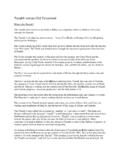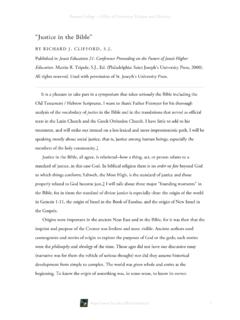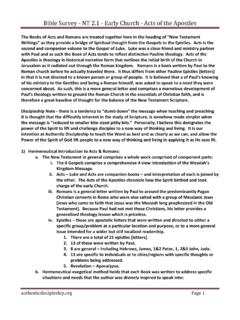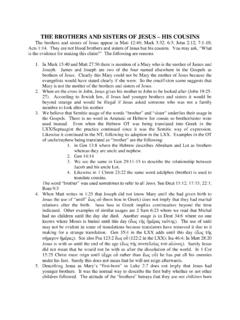Transcription of The Bible - Saint Alban Anglican Church
1 Masoretic Text1 Masoretic TextPart of a series onThe BibleBiblical canons and books Tanakh Torah Nevi'im Ketuvim Christian biblical canons Old Testament (OT) New Testament (NT) Hebrew Bible Deuterocanon Antilegomena Chapters and verses Apocrypha jewish OT NTDevelopment and authorship Authorship Hebrew canon Old Testament canon New Testament canon Mosaic authorship Pauline epistles Johannine works Petrine epistlesTranslations and manuscripts Samaritan Torah Dead Sea scrolls Masoretic text Targums Peshitta Septuagint Vulgate Gothic Bible Vetus Latina Luther Bible English BiblesBiblical studies Dating the Bible Biblical criticismMasoretic Text2 Historical criticism Textual criticism Source criticism Form criticism Redaction criticism Canonical criticism Novum Testamentum Graece
2 Documentary hypothesis Wiseman hypothesis Synoptic problem NT textual categories Historicity People Places Names Internal consistency Archeology Artifacts Science and the BibleInterpretation Hermeneutics Pesher Midrash Pardes Allegorical interpretation Literalism Prophecy InspirationPerspectives Gnostic Islamic Qur'anic Christianity and Judaism Inerrancy Infallibility Criticism of the Bible Bible book Bible portalThe Masoretic Text (MT, , or ) is the authoritative Hebrew text of the jewish Bible . While the Masoretic Textdefines the books of the jewish canon, it also defines the precise letter-text of these biblical books, with theirvocalization and accentuation known as the Masorah.
3 The MT is also widely used as the basis for translations of theOld Testament in Protestant Bibles, and in recent years (since 1943) also for some Catholic Bibles, although theEastern Orthodox continue to use the Septuagint, as they hold it to be divinely inspired.[1] In modern times the DeadSea Scrolls have shown the MT to be nearly identical to some texts of the Tanakh dating from 200 BCE but differentfrom MT was primarily copied, edited and distributed by a group of Jews known as the Masoretes between the 7th and 10th centuries CE. Though the consonants differ little from the text generally accepted in the early 2nd century (and also differ little from some Qumran texts that are even older), it has numerous differences of both greater andMasoretic Text3lesser significance when compared to (extant 4th century) manuscripts of the Septuagint, a Greek translation (madein the 3rd to 2nd centuries BCE) of the Hebrew Scriptures that was in popular use in Egypt and Israel (and that isoften quoted in the New Testament, especially by the Apostle Paul).
4 [2]The Hebrew word mesorah ( , alt. ) refers to the transmission of a tradition. In a very broad sense it canrefer to the entire chain of jewish tradition (see Oral law), but in reference to the Masoretic Text the word mesorahhas a very specific meaning: the diacritic markings of the text of the Hebrew Bible and concise marginal notes inmanuscripts (and later printings) of the Hebrew Bible which note textual details, usually about the precise spelling oldest extant manuscripts of the Masoretic Text date from approximately the 9th century CE,[3] and the AleppoCodex (once the oldest complete copy of the Masoretic Text, but now missing its Torah section) dates from the Nash Papyrus (2nd century BCE)
5 Contains aportion of a pre-Masoretic Text, specifically theTen Commandments and the Shema Text4 Origin and transmissionThe inter-relationship between various significant ancient manuscripts of the OldTestament (some identified by their siglum). LXX here denotes the original Talmud (and also Karaite mss.)states that a standard copy of theHebrew Bible was kept in the court ofthe Temple in Jerusalem for the benefitof copyists; there were paid correctorsof Biblical books among the officers ofthe Temple (Talmud, tractate Ketubot106a). This copy is mentioned in theAristeas Letter ( 30; comp. Blau,Studien zum Althebr.)
6 Buchwesen,p. 100); in the statements of Philo(preamble to his "Analysis of thePolitical Constitution of the Jews") andin Josephus (Contra Ap. i. 8).Another Talmudic story, perhaps referring to an earlier time, relates that three Torah scrolls were found in theTemple court but were at variance with each other. The differences were then resolved by majority decision amongthe three.[4]Second Temple periodThe discovery of the Dead Sea Scrolls at Qumran, dating from c. 150 BCE-75 CE, shows however that in this periodthere was not always the scrupulous uniformity of text that was so stressed in later centuries.
7 The scrolls shownumerous small variations in orthography, both as against the later Masoretic text, and between each other. It is alsoevident from the notings of corrections and of variant alternatives that scribes felt free to choose according to theirpersonal taste and discretion between different readings.[5] However, despite these variations, most of the Qumranfragments can be classified as being closer to the Masoretic text than to any other text group that has to Shiffman, 60% can be classed as being of proto-Masoretic type, and a further 20% Qumran style withbases in proto-Masoretic texts, compared to 5% proto-Samaritan type, 5% Septuagintal type, and 10%non-aligned.
8 [6] Joseph Fitzmyer noted the following regarding the findings at Qumran Cave Four in particular; "Suchancient recensional forms of Old Testament books bear witness to an unsuspected textual diversity that once existed;these texts merit far greater study and attention than they have been accorded till now. Thus, the differences in theSeptuagint are no longer considered the result of a poor or tendentious attempt to translate the Hebrew into theGreek; rather they testify to a different pre-Christian form of the Hebrew text".[7] On the other hand, some of thefragments conforming most accurately to the Masoretic text were found in Cave 4.
9 [8]Rabbinic periodAn emphasis on minute details of words and spellings, already used among the Pharisees as bases for argumentation, reached its height with the example of Rabbi Akiva (died 135 CE). The idea of a perfect text sanctified in its consonantal base quickly spread throughout the jewish communities via supportive statements in Halakha, Aggada, and jewish thought;[5] and with it increasingly forceful strictures that a deviation in even a single letter would make a Torah scroll invalid.[9] Very few manuscripts are said to have survived the destruction of Jerusalem in 70 CE.[10] This both drastically reduced the number of variants in circulation, and gave a new urgency that the text must be preserved.
10 New Greek translations were also made. Unlike the Septuagint, large-scale deviations in sense between the Greek of Aquila and Theodotion and what we now know as the Masoretic text are minimal. Detailed variations between different Hebrew texts in use still clearly existed though, as witnessed by differences between theMasoretic Text5present-day Masoretic text and versions mentioned in the Gemara, and often even Halachic midrashim based onspelling versions which do not exist in the current Masoretic text.[5] (Mostly, however, these variations are limited towhether particular words should be written plene or defectively - whether a mater lectionis consonant torepresent a particular vowel sound should or should not be included in a particular word at a particular point.)







